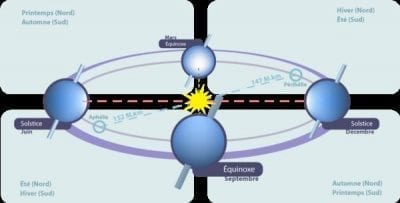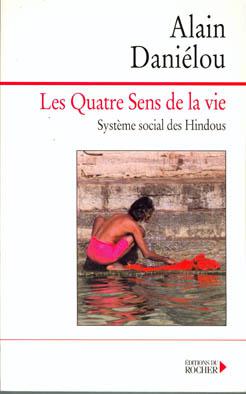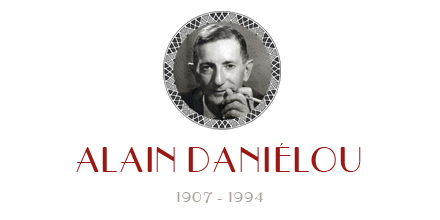Harsharan Foundation – Alain Danielou Study Centre
presents
Alain Daniélou and the Dance of the Gods
(provisional title)
a documentary by Riccardo Biadene
The Harsharan Foundation – Alain Daniélou Centre, committed to spreading the works of its founder, the Orientalist and musicologist Alain Daniélou, is producing a documentary with the provisional title Alain Daniélou and the Dance of the Gods, directed by Riccardo Biadene.
The film, shot both in the West (Italy, France, Germany, Switzerland, U.S.A.) and East (India), revisits the places where Daniélou lived and worked, interviewing those who knew him and/or have studied his works, revealing the impact his life dedicated to spreading the music and traditions of these areas – and particularly those of India – has had on world culture.
The film consists mainly of interviews and sketches of places, together with drawings and photographs from the Harsharan Foundation – Alain Daniélou Study Centre’s abundant archives. We have recently completed shooting at Zagarolo (Rome), Lausanne, Paris, New York, Venice, Berlin, Vicenza and Montepulciano, and shall shortly be travelling to Turin, London and, lastly, India.
Thus far, we have encountered and interviewed Sylvano Bussotti, Stephan Kudelski, Marcel Cellier, Jean-Pierre Pastori, André Kudelski, André Larquié, Alberto Sorbelli, Anne Prunet, Raghunath Manet, Jean-Paul Cluzel, Jean Clausel, Gabriel Matzneff, Sophie Bassouls, Shantala Shivalingappa, Dominique Nabokov, Francesca Cassio, Roman Vlad, Ivan Vandor, Raffaele Torella, Giorgio Milanetti, Giovanni Giuriati, Carla Bono, Antonio Rigopoulos, Lars Koch, Werner Durand, Peter Pannke, Ken Hurry, Ugo Bonessi, Grazia Marchianò, Roberto Perinu, Amelia Cuni, Anne Toual, Samuel Berthet.
The Harsharan Foundation – Alain Daniélou Study Centre was set up in 1969 by Alain Daniélou (1907-1994). The Foundation’s principle aim is to preserve, spread and promote Alain Daniélou’s manuscripts, archives, books and correspondence, as well as a considerable collection of photographs taken by Alain Daniélou and Raymond Burnier, their main subjects being the architecture and sculpture of India’s temples. Alain Daniélou and the Dance of the
Gods is the first documentary film project the Foundation has decided to produce. The project will seek the help of those organisations with which we have collaborated in the past, such as UNESCO, the International Music Council, the Musée de la Photographie at Lausanne, Casa Asia of Barcelona, the Intercultural Comparative Music Institute in Venice, the Rudra Béjart Ballet School of Lausanne, the Alliance Française branches in France, Italy and India, the ICCR (Indian Council for Cultural Relations) and IIC (Indian International Centre). Through these ties, forged during Alain Daniélou’s own lifetime and maintained by the Harsharan Foundation, we shall seek to ensure the project’s distribution throughout the world.
Solstice

The solstices and equinoxes are moments of great magic: they’re not manmade; they don’t just concern our little world and not even just our solar system, but the whole cosmos! We are, however, capable of establishing their date and time which, this year, is on June 20th at 23.09 UTC, meaning 8 minutes past midnight on June 21st at our longitude, although it won’t change anything! But that’s the will of the gods!
Actualité
Apple store link: https://books.apple.com/es/author/alain-dani%C3%A9lou/id373671620
Visit Amazon.com’s Alain Danielou Page and shop for all Alain Danielou books and other Alain Danielou related products (DVD, CDs, Apparel). Check out pictures, bibliography, biography and community discussions about Alain Danielou
Youtube
Tagore’s Songs of Love and Destiny
Translated and specially transcribed for voice and piano by Alain Danielou (1907/1994) Presented by Francesca Cassio (vocalist) and Maestro Ugo Bonessi (piano)
Introduction and presentation of Tagore’s songs in Bengali by Dr. Reba Som Collaboration: Italian Embassy Cultural Institute; Alain Danielou Center; and Delhi Music Society,
Rabindranath Tagore Centre, ICCR, Kolkata
http://www.youtube.com/watch?v=gqF6tirmLOM
Archives
THE FOUR AIMS OF LIFE
 Among the Hindus, self-realisation includes four aims to be achieved by every man at a given moment of his life. These four aims are the acquiring of knowledge, self-realisation at a physical level, material achievements and, lastly, detachment. Individual realisation cannot be achieved outside the social structures.
Among the Hindus, self-realisation includes four aims to be achieved by every man at a given moment of his life. These four aims are the acquiring of knowledge, self-realisation at a physical level, material achievements and, lastly, detachment. Individual realisation cannot be achieved outside the social structures.
The first part of this book explains the caste system and its origins. At the time of the Aryan invasions, Shivaite religion and philosophy predominated among the peoples of India. As a regulator of stability between the Aryans and the indigenous populations, the caste system avoided any pernicious crossbreeding and preserved differences, establishing an organised society ensuring a livelihood for all, with the right to keep their own beliefs and social institutions. Daniélou then describes the creation of an artificial, ideal, perfect, scholarly language: Sanskrit, belonging to no one and to everybody, used for communication among the various groups.
Virtue, Success, Pleasure, Liberation
The Four Aims of Life in the Tradition of Ancient India Inner Traditions International, 1993.
The second part expounds the basis of the social order. Daniélou first explains that history and the movements of the universe are conceived of as a cycle. The universe is not made of continuous matter, but of relations between two governing energy forces – centripetal and centrifugal – which determine the movements of the planets, stars and atoms. This view of the universe, founded on discontinuity and non-Euclidean geometry, recalls the post-modern perception of the world. Daniélou then describes the different cycles of mankind. The first beings appeared on earth during the Golden Age, the Satya Yuga. They were known as “the Far-Seeing”, and were able to detect the laws that govern the world, in some ways recalling the Celtic Druids, to whom exceptional powers and knowledge were also attributed, and who were also known as “seers”.
More than any other work, The Four Aims of Life is a eulogy on respect for diversity:
For the Hindu, such levelling is indicative of the suicidal tendency of a species, inasmuch as the intensity of life is based on its wide range of differences, while levelling in any order of things is always the symbol of death itself.
This book is an excellent guide, proposing rules of life and conduct from a Hindu point of view, and also covers the preoccupations of westerners today.
This book presents the caste institution and the often surprisingly modern conceptions of an archaic society whose structures, ways of life, beliefs and ethics have survived in spite of wars, invasions, reforms and progress, Bulletin du livre, juillet 1976
Anne Prunet and Marie- Laure Bruker
![]()
UK premier proved a treat for Tagore fans
By JUDY LLOYD
THIS year is the 150th anniversary of the birth of the renowned Bengali poet Rabindranath Tagore, whose beautiful songs and poetry took the western world by storm in the first part of the 20th century.
Indeed, in 1913, following promotion by the poet WB Yeats, Tagore was awarded the Nobel Prize for Literature for his Gitanjali – translated as Song Offerings – a great collection of song poems covering a multitude of themes and moods.
Last Sunday Moot Music spent an afternoon in the company of Riding Mill poet William Radice – until his recent retirement, senior lecturer in Bengali at the School of Oriental and African Studies, London University.
He is one of the foremost modern translators of Tagore’s poetry and has spent much time over the last year lecturing throughout the world on his work.
An appreciative audience gathered in Hexham’s Moot Hall to hear him introduce what was almost certainly a UK premier of settings of some of Tagore’s songs.
…………………
As usual, the setting of the 15th century Lockhart room provided an intimacy of venue which well suited the occasion and a clarity of acoustic which allowed the singer and pianist to imbue each phrase with emotion and meaning without having to over project.
We were also privileged to hear a recording, brought by William Radice, of Tagore singing one of his own songs in Bengali and, during an informal question time he spoke with great knowledge of the ways in which Tagore’s musical lyrics have been reinterpreted down the years, for better and worse, by a nation which still idolises him as one of its greatest writers and thinkers.
All those who attended will want to thank William, Lucy and Sarah for an exceptionally well designed and unusual treat.
The next Moot Music event returns to more familiar territory, but at the less familiar time of 7pm on Tuesday, December 20, when Andrew Passmore will be visiting with Chorus Natus Est, a small chamber choir of post graduate music students.
They will be giving a chamber group performance of music from Handel’s Messiah, together with settings of carols and other Christmas music.
NEW GLOBAL INDIAN:
Extract:
“I’ am a poet of the world, I try to capture its melody, wherever it rises”, was Tagore’s aspiration. Tagores’ relevance today lies in his universal outreach. His views retain its pragmatic fervour in present world. He melded ideas, traditions, practices and cultures of places, panning the globe and this resulted in the Tagorean exuberance for the posterity to reckon as contemporary ever after.
Dr Samuel Berthet, a historian of contemporary history feels the creation of Shantiniketan and Sriniketan has a long way to go. ‘The poet gave altogether another dimension to this attempt for a social paradigm over four decades. Direct and daily access with its lively tenants in the rural areas and in collaboration with scholars and artists from all over India ….to rediscover heritage…by getting back to one’s own roots and reviving in a lively manner the links between popular and elite culture, rural and urban culture, under the form of an international forum was and remain a pioneering one….The legacy of this pioneering venture led by the poet is multi pronged and has been carried both in the subcontinent and other parts of the world.’
………………………..

